Evolution And The Scorpion Animal Or Crustaceon?
For many years at present, in that location is a full general consensus about the fact that scorpions can exist classified among the most ancient and conservative arthropods both in origin and body morphology. They first appeared every bit aquatic organisms during the Silurian (approximately 450 million years agone – MYA) and plainly experienced few morphological changes since that period [1,2,three]. Because of their apparent conservative course some authors attempted to define the group as 'living fossils' (Fig. one). All the same, this assumption is incorrect since scorpions most certainly underwent major biochemical, physiological, behavioral and ecological adaptations that have combined to ensure their continued success over the by 450 million years [2].
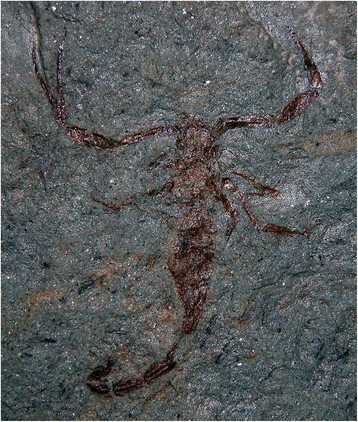
Protobuthus elegans Lourenço & Gall. Fossil scorpion from Early Triassic, France. The specimen, an adult male, clearly presents a telson
Another widespread opinion is that scorpions are a rather depauperate group inside the class Arachnida with approximately 2200 known species up to the present. It is obvious that the order can be considered modest when compared to that of other arthropods. The known number of species is much less impressive than those known for groups such as insects with over one million species or spiders with almost 40,000 species. Withal, the number of known scorpion species until the end of the nineteenth century (years 1899–1900) was approximately of 250. By 1975, this number reached 700 species. In present the days, only twoscore years later, this number was multiplied past three. The increased number of described species is mainly due to the new techniques used in the prospection of scorpion in the field, but too to a improve resolution in the definition of several populations [4,v,six,seven]. The use of new techniques is often coupled with the exploration of new distinct habitats and microhabitats such as caves and organic soils. This leads to the discovery of completely unexpected elements (Fig. 2) [iv, 8, ix]. In account of the progress achieved in the noesis of different scorpion fauna such as those of tropical America, tropical Asia, Africa, Madagascar and Nearctic and Palearctic regions, one can expect that the total number of species may accomplish to 5000 or even more in the coming decades.
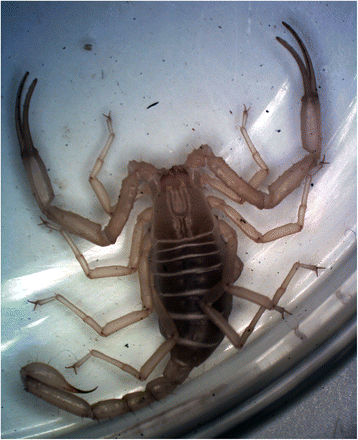
Vietbocap thienduongensis Lourenço & Pham (Pseudochactidae). A cave scorpion from Vietnam, the specimen is an adult male (copyright by D.-S. Pham, reproduced with permission)
If the total of species surpasses at present 2200, only a minority of these can be perceived by people in full general. This is directly associated with the fact that virtually scorpion populations in nature are represented by very inconspicuous numbers of individuals, sometimes only a few thousands to a few hundreds. In other words, most scorpions are extremely rare.
Contrarily to scorpion experts who may consider these as fascinating animals for enquiry, the allure shown by humans in general is mainly connected with their negative reputation of 'man killers'. Naturally, the species that represent a cause for fearfulness and threat to humans are amid those presenting dense populations represented by millions of individuals. The association betwixt their noxious condition and massive populations, that can be found in pre-urban and even urban habitats, contribute to their infamous reputation [x, eleven]. Notwithstanding, only a express number of species, probably less than l, are really responsible for serious or lethal incidents. From the beginning of the twentieth century on [12], it was obvious that the involvement on scorpion inquiry in many distinct biological fields was generated past the fact that a few species possess venoms with potent toxins, capable of killing humans [x, 11].
Ii questions are ofttimes addressed concerning the baneful species of scorpions: (i) why a relatively small number of species possess venoms with potent toxins capable of killing humans? and (two) why infamous species of scorpions accept their distribution express to certain regions of the world such as N and South America, North Africa, Middle East and certain regions of Asia? In other terms, why and so many other regions of the world are spared from this miracle?
Scorpion venoms accept been studied for more than a century, and some interesting results were revealed since then [thirteen, xiv]. Nevertheless, the evolutionary significance of mammal-specific toxins remains largely unsolved fifty-fifty if some attempts have been made to explain some possible evolutionary paths.
The deadliest species of scorpions belong to the family Buthidae C. L. Koch, with a few exceptions constituted past species of two other families, Hemiscorpiidae Pocock and Scorpionidae Latreille. In a didactical purpose, however, I will restrict my present assay to elements of the family Buthidae. The conclusions I nowadays in this work should be considered tentative, since our global knowledge of scorpion evolution presents yet numerous gaps. The main purpose is to bring some clarification, even if partially, to the previously noted questions, and to address possible explanations to not-specialists whose research embraces scorpions in several fields such as venom toxins and public health.
The evolution of toxins
Although toxins may exist one of the most of import aspects to be considered in this analysis, I am but a zoologist; therefore, the subject is quite far from my domain of expertise. Consequently, I will limit myself to some general aspects.
For many decades, in that location have been an impressive amount of contributions to the domain of toxins – incommunicable to cite them all here – and quite many were synthesized in books [15]. Complementarily, some well-nigh interesting comparative assay have also been produced more recently [xiii]. Nevertheless, in the majority of these studies, the basic questions were addressed on how these toxins act, and how they collaborate with a given organism once inoculated. Studies addressing the question on why a given toxin evolved to be agile on a given organism are much less frequent. Only a few years ago a more than precise hypothesis was formulated attempting to explain the causes of the evolution of some scorpion toxins, noticeable in relation to mammals [16].
The origin of mammal-specific toxins was suggested as an important result in scorpion development. One-time Earth lineages of Buthidae with very stiff neurotoxic venom, such every bit the genera Androctonus Ehrenberg and Leiurus Ehrenberg, share carve up mammal- and insect-specialized neurotoxins that are specific for Na + channels [17]. Inversely, New World genera such as Centruroides Marx and Tityus C. L. Koch take potent toxins acting on both mammals and insects. It was suggested as quite possible that the separate mammal-specific Na + toxins could have evolved during the aridification of the Palearctic region during the Tertiary period, when one of the almost important selective factors was rapid radiation of small burrowing mammals (generally rodents) in barren landscapes. Such newcomers to the scorpion surround, including rodents, would be a direct competitor for space (burrows) and in add-on important nocturnal predators, as many of them are today [xviii]. This pressure could tentatively explain the emergence of specific mammal-targeting toxins, used mainly for defence, merely non for foraging [17].
This hypothesis, although interesting, does not accost all possible questions, since it cannot conspicuously justify the evolution of mammal-targeting toxins in New-World lineages and, in particular, in those present in regions where intensive aridification did non take identify, such as in Southward America. Possibly the absenteeism of more upward to date explanations leads some contempo authors to reconfirm this hypothesis [nineteen].
Back to the more basic functions of scorpion venom and toxins, it is currently accustomed that their master role is associated with predation rather than defense [13]. Among modernistic (extant) scorpions, merely a few species prey and feed on mammals (Fig. three) and they practise not vest to the family Buthidae. Only big scorpions generally can casualty on minor rodents, and well-nigh belong to the family unit Scorpionidae, genera Pandinus Thorell and Heterometrus Ehrenberg, for instance. These large scorpions, some of which can reach well-nigh 25 cm in length, possess very strong pedipalps (Fig. 4) and predation can exist performed only mechanically, without the use of venom. In other words, they do not sting the prey.
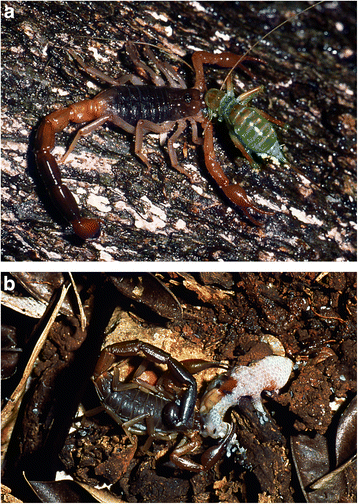
Grosphus flavopiceus Kraepelin from Madagascar. An adult female feeding respectively on (a) an insect (Orthoptera) and on (b) a gecko (Reptilia)
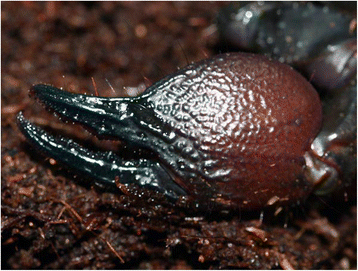
The very strong pedipalp-chela of a Pandinus imperator from Africa (copyright by Due east. Ythier, reproduced with permission)
Amidst Buthidae species, predation is largely full-bodied on arthropods, mainly insects and spiders, and only isolated cases of predation on small-scale vertebrates take been recorded [xx]. Consequently, the evolution of very active mammal-specific toxins in several groups of the Buthidae family remains controversial.
What fossils can tell us well-nigh the development of venoms?
As it was recently summarized, scorpions first appeared as aquatic organisms [2, three]. In their evolutionary history, they almost certainly evolved from the Eurypterida ('water scorpions') since both groups share several common morphological features. Marine and amphibious scorpions most certainly persisted well into the Carboniferous (359–299 MYA) and some species probably reached the Permian (299–251 MYA) and Triassic (251–200 MYA) periods [21, 22]. The first unequivocally terrestrial (air-breathing) scorpion about certainly appeared on state during the belatedly Devonian (416–359 MYA) or early on Carboniferous [1, 23].
These early scorpions, nearly all aquatic or amphibious, diversified rapidly into an impressive number of superfamilies and families. All these non-terrestrial fossil scorpions have been placed in one suborder the Branchioscorpionina Kjellesvig-Waering. Fossil scorpions, clearly accepted equally terrestrial forms, are classified into a distinct suborder Neoscorpionina Thorell & Lindström, together with extant families. The suborder Branchioscorpionina includes 18 to 21 superfamilies and 41 to 47 families co-ordinate to different authors [24, 25]. These numerous lineages are a clear indication of their early and great success. Moreover, because the fossil record is rather bitty, these more than than 20 superfamilies are probably only a fraction of the total number that really existed [1, 24]. It is clear, still, that only a few – possibly only 1 of these lineages – survived and evolved into present mean solar day species. Naturally, all extant scorpions live now in land.
The important number of fossil scorpion families accepted past strict paleontologists creates a divergence of stance with neontologists. This divergence of opinion clearly indicates a taxonomic problem, and the difficulties of this blazon are often the upshot of unlike approaches in the studies performed past paleontologists and neontologists. The get-go working from the higher categories downwards and the 2d from lower categories upwards [24].
One important question concerns the age of extant scorpion lineages. Until recently, modern scorpion lineages were estimated to have been present since the very early Cenozoic [24]. This estimation was based on a few fossil records bachelor for the Cenozoic and Mesozoic periods. Very contempo discoveries for both the Cenozoic and Mesozoic periods based on both sedimentary and bister fossils attested that some extant lineages or at least proto-elements of these lineages are about certainly much older and were already present in the Lower Cretaceous [3, 26,27,28,29].
Without any exception, all the extant scorpion species possess venom glands (Fig. 5). The presence of a telson with an aculeus and, in some cases, possibly tegumentary glands are likewise evident in several scorpion fossils from the Palaeozoic, Mesozoic and Cenozoic [one, 3, 23, 29,xxx,31] (Fig. 6).
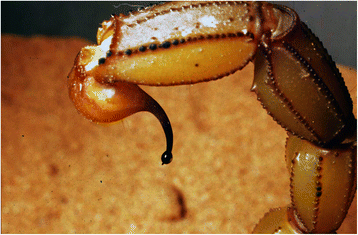
Telson of an extant buthid, Buthus lienhardi Lourenço. An adult female from Morocco
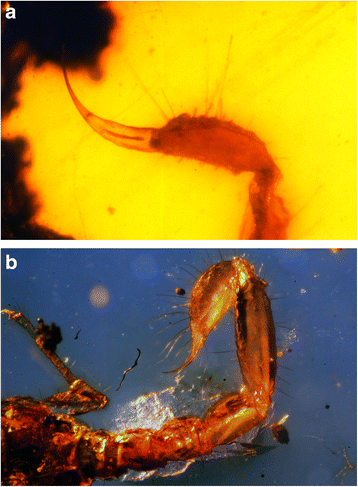
Telsons of two Early Cretaceous bister fossils from Burma, Myanmar. a Palaeoburmesebuthus grimaldi Lourenço (Palaeoburmesebuthidae). b Chaerilobuthus schwarzi Lourenço (Chaerilobuthidae) (b copyright past J. Velten, reproduced with permission)
Tegumentary glands are common in many arthropods and these probably evolved from the secretion of basic enzymes to more and more than elaborate toxins, thus becoming complex venom glands. Based on the assumption that venom glands in scorpions have originally a predatory and digestive role, it is possible to suggest a process of coevolution between mechanical design of predation and the venomous part. This hypothesis appears every bit a good model for the elements of the buthoid lineage that generally have slender and/or weak pedipalps.
The precise evolution of the telson remains unclear. The structure was already present in Eurypterids and is yet common in several arthropod groups such as Xiphosura (horseshoe crabs). This posterior-most division of the body of an arthropod is not, withal, considered as a true segment since information technology does not arises in the embryo from teloblast areas as do real segments. Equally for its possible original function in scorpions, the post-obit paths tin can be suggested. The telson probably played a major mechanical role in predation, with the aculeus interim equally a 'spear-head'. Several fossil scorpions of the buthoid lineage evidence quite long aculei and this is also the instance of a few extant genera of buthids such as the genus Buthacus Birula or Buthiscus Birula [3, 32]. Over the course of evolutionary time, tegumentary glands evolved into the telson vesicle, still, their archaic office was basically only digestive. In contrast, several non-buthid groups adult mechanical techniques of predation with the development of very strong and well-armed pedipalps. These groups do possess venom glands; however, the utilise of venom (toxins) for the capture of casualty remains rather facultative.
Naturally, this previous argumentation, although of some interest, does non explains why some groups of extant buthids do possess very active venoms, in particular against mammals, while others practise not. I volition try to reconsider this betoken in the coming sections related to the evolution and distribution of noxious buthids.
Buthoid composition and the evolution of distinct lineages
The classification and the phylogeny of scorpions are globally circuitous and cannot be detailed in this limited analysis. The buthoids probably announced as the most complicated group since they represent about fifty% of all known scorpions and are the only group to be distributed in all the biogeographic regions of the earth.
Although some authors (mostly theoretical phylogeneticists) try to insist on the possible 'monophyletic' character of this group of scorpions, it seems that this cannot be the case. This superfamily, that most certainly comprises a small number of distinct families, cannot correspond a homogeneous unit of measurement. Instead, it seems to exist represented past four to five dissimilar evolutionary gradients [2, 33]. Nevertheless, the acceptation of several families inside the buthoids or several subfamilies within the buthids is purely a theoretical exercise and has pocket-size consequences on the present global approach to the evolution of noxious species.
Among the limited number of buthoid species possessing venoms formed by complex mixtures of highly specific toxins almost all belong to genera that can be placed in a high or even very high evolutionary level inside the familial lineage. Coincidently, these genera including Androctonus, Buthus Leach, Leiurus, Mesobuthus Vachon, Parabuthus Pocock, Centruroides and Tityus have all been the subject of intensive biochemical and molecular enquiry [17]. Most biochemical studies are concentrated on these groups considering they are responsible for most scorpion incidents, but also because they are represented by conspicuous populations. Contrarily, almost no study has ever been performed on the most primitive lineages, both because these do not represent any threat to humans and because these scorpions are generally rare. These groups correspond to a number of relictual genera among which can exist cited Ananteris Thorell, Anomalobuthus Kraepelin, Akentrobuthus Lamoral, Birulatus Vachon, Egyptobuthus Lourenço, Himalayotityobuthus Lourenço, Lychasiodes Vachon, Microtityus Kjellesvig-Waering, Pseudouroplectes Lourenço, Sabinebuthus Lourenço, Tityobuthus Pocock etc. I will try to associate these different lineages or gradients with fossils and biogeography in the following sections; but before some clarifications on biogeography patterns may be necessary.
Biogeographic patterns presented by scorpions
Previously to considerations on the precise patterns of distribution of scorpions and in particular of the noxious species, it seems of import to comment on some more full general patterns defined in the last two or 3 decades.
Studies on scorpion biogeography are not recent. Attempts to translate the observed models of distribution started since the finish of the 19th century [34,35,36], but the general patterns of distribution so proposed were non in understanding. In fact, the viewpoints of the different authors were frequently quite distinct. These early general contributions have been followed but past regional biogeographic studies with a weak impact [37]. Only past the heart of the 1980s some new contributions on Neotropical scorpions allowed the definition of some biogeographic patterns [37,38,39]. The definition of these patterns became possible due to a better knowledge of the phylogeny of several groups, the application of contempo hypothesis concerning climatic vicissitudes in tropical biomes during the late Cenozoic and Pleistocene periods and a much better knowledge of scorpion life-history strategies. Until the 1980s, no author ever took into consideration whatsoever parameters of life-history strategies to explain scorpion distribution. Notwithstanding, once again starting in the 1980s, several biological and ecological studies demonstrated that well-nigh scorpions should exist defined as equilibrium species, presenting therefore very anticipated patterns of distribution [40, 41].
Subsequently, a more detailed biogeographical model was proposed [37] based on Udvardy's [42] division of biogeography into three spatial-temporal scales (Fig. 7). This arroyo proved to be clear and didactic and 3 major biogeographical events were suggested to explicate about of the patterns of distribution observed among scorpions today.
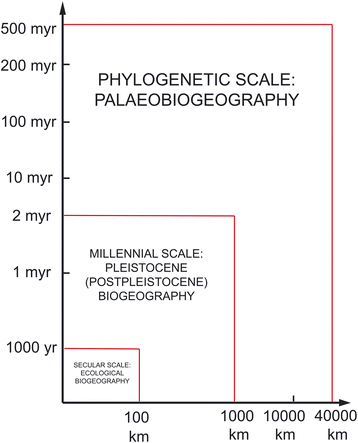
Division of biogeography into the three spatial-temporal scales of Udvardy (modified from Udvardy [42])
The first scale globally defined as phylogenetic or paleobiogeographic encompasses the evolutionary time of all biota and is limited in space just by the size of the earth [42]. On this scale, only historical factors tin be causeless to have taken place since, for almost all ecological atmospheric condition, information are largely or totally unknown. At this level, the evolutionary process of biogeography is, to a considerable extent, a tributary of continental drift and plate tectonics. This new view shook the foundations of many theories adopted by older paleontologists and biogeographers [42].
Continental drift was taken into consideration by few authors when they discussed aspects of regional biogeography. The contribution of Lamoral [43] on the suprageneric classification of recent scorpions, with discussion on their zoogeography, was an of import attempt to explain some general patterns and several of his suggestions are mostly acceptable. He probably overestimated the role of dispersion when affirming that two major factors have influenced speciation and distribution patterns. 1 is the fragmentation of Pangaea and Gondwanaland; the other is the motion of Laurasian elements to the north of Gondwanaland. This 2nd factor should be reconsidered. The process of 'agile' dispersion should rather be interpreted equally being a more 'passive' process in the dispersal sense every bit defined by Haffer [44]. This signal is globally supported by the poor vagility presented in modern species of scorpions. Nevertheless, the nowadays disjunctive distributions of several families and genera of scorpions remain unexplained. The cases of the present disjunctive distribution of some scorpion groups should be regarded as the result of the previous distribution of proto-elements of families and genera, followed by a vicariant process. The precise mechanism of these processes is non, all the same, always known. In conclusion, the main outcome responsible for the distribution of scorpions on a paleogeographic scale is the fragmentation of Pangaea and subsequent continental drift. The difficulties to explain the discontinuous distribution of some familial and generic groups bespeak non only to the great geological age of these groups, but also to the relict faunas and biogeographical patterns that they showroom currently.
The 2nd scale used in scorpion biogeography can exist defined every bit millennial or Pleistocene biogeography. Between the development of the earth's crust and the Pleistocene epoch several events took identify, many of which were related to the continuous drift of the continents. Some examples are mountain building, differential erosion, epicontinental seas, climatic-vegetational fluctuations, changes of world sea level and the formation of major river systems. These events took place during the Cenozoic over a period of 60 MYA, and have influenced the present biogeographical patterns of scorpions. Climatic-vegetational fluctuation most certainly played a major role, starting on the late Cenozoic period, only having a major touch during Pleistocene time [44, 45].
During many years nearly contributions apropos tropical regions stated that the biogeographic and variety patterns observed in these regions could be explained by the long stability of tropical forests over millions of years [46, 47]. Subsequent studies on geology, paleoclimates and palynology, especially in Amazonia and Africa [48,49,50,51], demonstrated that this presumed stability was a fallacy. In fact, although the temperatures in tropical lowlands remained 'tropical' during glacial periods (iii to five °C lower than today), the forest broke into isolated remnants during cool dry periods (glacial phases). The remnants of wood expanded and coalesced during warm humid periods (interglacial phases). Conversely, nonforest vegetation expanded during glacial and retreated during interglacial phases (as at present). Data from geoscience, however, have been insufficient to indicate the precise areas of changing forests and nonforests and, in item, the areas in which forests remained during arid phases, presumably serving as refugia for beast and establish populations. Yet, in the Neotropical region, studies on the biogeographical patterns of scorpions [38, 52, 53] suggested several endemic centers that are well correlated with the results obtained by Prance [48] on woody plants, and Haffer [54] on birds.
The third calibration too used in scorpion biogeography is divers as 'ecological biogeography'. However, this scale was globally rejected in pioneer biogeographic studies, mainly because it was biased towards two major considerations:
- (i)
an well-nigh full lack of cognition of life history strategies, more precise information on this subject field was only available from the 1970s and 1980s on, but was almost the only preoccupation of ecologists;
- (ii)
a generalized opinion, even among modern biologists, that scorpions are capable of withstanding radical changes in environmental conditions, and therefore of being very good colonizers. This assumption is evidently fallacious. With growing knowledge on scorpion life history strategies information technology was clearly axiomatic that many, if not most scorpions, are equilibrium species, which tend to inhabit stable and predictable natural environments, produce single egg clutches, do not shop sperm, take long life spans, present low population densities, have a very depression rmax, show weak mobility, and are highly endemic [39,twoscore,41].
In contrast, it is truthful that a minority of scorpions show traits of 'opportunistic species'. Most of these opportunistic elements belong to the family Buthidae, but a few can also exist associated with other families such as Euscorpiidae and Hormuridae. They are marked by ecological plasticity and are readily capable of invading disturbed environments. They may produce multiple clutches from a single insemination, have elaborate sperm storage capabilities [55], short embryonic development, short life spans, high population densities, rapid mobility, and are widely distributed. The written report of these opportunistic species is globally of little interest for the definition of biogeographical models.
Opportunistic species thrive in disturbed and unpredictable environments that tin can be the result of natural causes (e.g.; volcanic activeness) or are directly associated with man action. Several classical examples can be outlined, including the populations of the Neotropical species Centruroides gracilis (Latreille) that are established in the Canary Islands for virtually 2 centuries [35, 41]. In addition, although the originally Sri-Lankan species Isometrus maculatus (DeGeer) has nowadays a worldwide distribution in tropical and semi-tropical regions, this species has been transported past humans during the last four centuries. The replacement of species is well illustrated in several islands of Eastern Asia where natural volcanic activity and human being bear on are important [56].
In continental regions, opportunistic species can rapidly occupy habitats disturbed by human being activities, where the original native species take been selected against, thus leaving their ecological niches vacant. Several examples are known past scorpion experts, as in the instance of numerous noxious species of the genus Centruroides distributed in Mexico, and largely influenced past the anthropic action. One particular example is well known past biologists in full general and concerns the remarkable expansion of the noxious Brazilian species Tityus serrulatus Lutz & Mello during historical times [57, 58]. This particular instance was already discussed in detail [10, 11].
The association of different evolutionary lineages with fossil records
When the existence of four to 5 distinct evolutionary gradients was start suggested [33], the knowledge of well-preserved fossils from Mesozoic and Cenozoic periods was however poor. In the terminal ii decades, however, a good access to new fossil elements become possible bringing some new clarifications on the human relationship between extant elements and those from early Mesozoic to late Cenozoic. A few conclusions are possible.
Some sedimentary fossils from the early on Triassic such as the family Protobuthidae Lourenço & Gall tin can already be classified amidst elements of the buthoid in sensu lato [23]. However, no precise connections can exist done to precise extant generic groups for instance. More recent Cretaceous bister fossils propose some early on links with extant lineages, and some well-defined families such as the Archaeobuthidae Lourenço from Cretaceous of Lebanon and Palaeoburmesebuthidae Lourenço from Cretaceous of Burma can clearly be assigned to the a buthoid lineage [3, 26, 27, 59]. However, the link betwixt the most mutual Cretaceous burmite genera, Palaeoburmesebuthus Lourenço and Betaburmesebuthus Lourenço (Fig. 8), with extant genera remains vague. In fact, these two burmite elements testify very archaic characters that apparently vanished in recent forms [3]. Nevertheless, in a few other isolated cases, elements from Cretaceous burmite were proven to be directly associated with the Buthidae family unit and to extant elements. I instance is Archaeoananteroides maderai Lourenço that was clearly related to the extant genus Ananteroides Borelli [60].
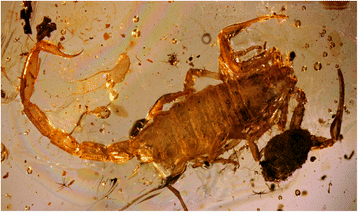
Betaburmesebuthus bellus Lourenço (Palaeoburmesebuthidae). Young male from Early-Cretaceous amber of Burma (copyright past C. Gröhn, reproduced with permission)
Although Cenozoic sedimentary fossils are extremely rare [31], a number of amber elements from this period has been discovered and studied in the last three decades. Before elements from this period can be dated from the Palaeocene to Eocene and globally correspond to pieces found in Baltic amber [61]. All studied scorpions from this period were classified in the family Buthidae, and with one single exception, were all assigned to the subfamily Ananterinae Pocock (Fig. 9) [three, 30], which can be ranged among the lower evolutionary buthoid gradients [33]. Information technology is important to recall that all the extant elements belonging to the Ananterinae are globally not noxious and although rare nowadays a wide range of distribution over different continents such as Africa, tropical America, and Asia (Fig. ten). The present pattern of distribution of the Ananterinae suggests a panbiogeographic model and the grouping was well-nigh certainly ascendant over all emerged lands in early Cenozoic.
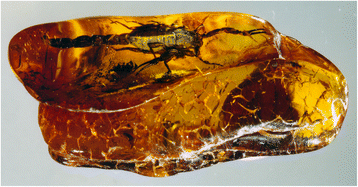
Palaeoananteris ribnitiodamgartensis Lourenço & Weitschat (Buthidae). Adult male person from Early-Cenozoic Baltic bister
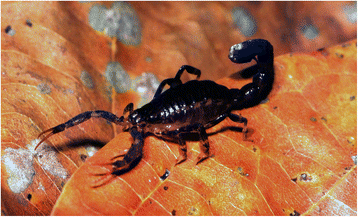
Ananteris charlescorfieldi Lourenço (Buthidae, Ananterinae). Adult female from Republic of bolivia
A number of late Cenozoic elements are as well known from Dominican and Mexican amber. The dating of this American bister can be controversial, but is ordinarily suggested as Oligocene-Miocene. The characteristic trait of the elements found in this belatedly Cenozoic amber is that all, without exception, can be classified amid typical American extant groups such every bit Centruroides, Tityus and Rhopalurus Thorell. Just distinct species were described from this type of amber [62,63,64]. It is important to notice that these genera can be classified among the most evolved inside the evolutionary gradients defined for the buthoids [33]. Unfortunately, no fossil records are available for other noxious groups such as the African/Center Eastward genera Androctonus, Buthus, Hottentota Birula, Leiurus, Mesobuthus and Parabuthus. Nevertheless, the fossil chronology suggests the development of noxious species, probably from the middle of Cenozoic epoch, and correlates well with the hypothesis suggesting that mammal-specific toxins would have evolved during aridification of the Palearctic region during the 3rd period [xvi].
The evolution of these more evolved buthoid groups certainly took place in many regions of all emerged lands. Their present, and somewhat, more located regions of distribution can largely be attributed to more recent geological and paleoclimatical vicissitudes that took place from the middle to the end of the Cenozoic epoch and even during the more recent Pleistocene flow. In all cases, these correspond well to the events defined for the second and third scales used in scorpion biogeography, divers as millennial/Pleistocene and ecological biogeography. In the side by side section, I will endeavor to provide some examples.
Noxious species in the Saharo-Sindian scorpion fauna
The Saharo-Sindian region comprises most of the faunal elements distributed from northwest Africa to India via the Middle East [65]. This naturally includes several genera containing noxious species such as Androctonus, Buthus and Leiurus. The present composition of this fauna is, in fact, the heritage of ancient faunas present in Due north Africa and the Palearctic region since the beginning of or, at least, middle Cenozoic times [66, 67]. North Africa and the Palearctic region have experienced numerous paleoclimatological vicissitudes during the final few million years, some even in more or less recent Quaternary periods. The Sahara, for example, has undergone a series of wet periods, the most recent occurring from ten,000 to 5000 years earlier present (BP), and it was not until most 3000 years BP that the Sahara assumed its present arid state [68]. Fifty-fifty though recent studies suggest that the Sahara desert may be much older than was previously thought [69], it seems reasonable to postulate that extremely arid areas have always existed equally patchy desert enclaves, even when the full general climate of North Africa enjoyed more than mesic conditions.
In these arid and desert regions of both the North African Sahara and the Palearctic region, a specialized scorpion creature would have evolved in response to the dehydration. These 'ancient lineages' adapted to arid weather, undoubtedly correspond to extant groups such as genera Androctonus, Buthacus, Buthiscus, Buthus, and Leiurus some of which are typically psammophilic. Information technology is important to emphasize the fact that these lineages must accept been present in Northward Africa for at least 10 to 15 MY [70, 71], and as well in the Palearctic region during subsequent periods [67]. To discover that among the lineages positively selected, not all correspond to groups possessing baneful species.
In contrast, other lineages less well adapted to aridity and, previously, only present in more mesic environments, take regressed markedly in their distribution with the expansion of the desert. In consequence, they have, in some cases, already experienced negative option and doubtless will eventually disappear. In other cases, populations accept been reduced to very limited and patchy zones of distribution, sometimes with remarkable disjunctions in their patterns of distribution. It is noticeable to recall that these less well-adjusted or more primitive lineages have no noxious species. Ane proficient example is the genus Butheoloides Hirst [72].
The models of the distribution of North African scorpions observed today tin be summarized as follows: a core Saharian region, described by Vachon [66] equally the 'primal compartment', in which only the groups all-time adapted to xeric conditions (such equally the genera Androctonus, Buthacus, Buthiscus, Buthus, and Leiurus) are distributed. In the peri-Saharian zone, surrounding well-nigh of the primal compartment, some remarkable disjunctions occur. I of them is presented past the genus Microbuthus Kraepelin with species in Mauritania and Kingdom of morocco in the Due west and other species in East Africa and Centre East [73]. Finally, several groups, sometimes less well adjusted to xeric environments, take their populations limited to refugia [66]. These refugia are represented by the Saharan massifs, such as Hoggar, Aïr and Adrar, too every bit other elevated regions in Islamic republic of mauritania and Occidental Sahara. Some of the owned genera, such as Cicileus Vachon, Lissothus Vachon, Egyptobuthus and Pseudolissothus Lourenço provide useful examples [66, 74, 75]. A similar picture can be observed in several regions of the Center East, in detail amongst the mountain ranges of Iran and Afghanistan [67].
Species from the Amazon region
The biogeographical models observed for Neotropical scorpions suggested direct correlations with climatic-vegetational fluctuations during the Pleistocene. I of these models confirms the presence of polymorphic species in the Amazon region, mainly belonging to the genus Tityus. Some of these species are strongly noxious while others are not. A few can have wide ranges of distribution from French Guiana to Peru, but most are express to zones in eastern or western Amazonia. It was suggested that during the dry periods of the paleoclimatic episodes when the wood was reduced to small patches, widespread species became fragmented into several isolated allopatric populations. These isolated populations of ecologically adaptable species (which is the case of some Tityus spp.) rapidly recolonized the reestablished wood during wet episodes. Previously isolated populations thereby became contiguous. Temporary reproductive isolation did not produce genetic barriers (at least for scorpions) and merely small morphological differences evolved. Where species reunited, the variation was no longer geographically correlated.
Some other observed model corresponds to disjoint distributions of species of a given genus present in savanna and rainforest formations. Examples tin can be provided by species near exclusively adapted to savannas (genus Rhopalurus Thorell) or to rainforests (genus Hadrurochactas Pocock). Isolated owned populations provide skilful bear witness for the hypothesis of past connections between the savannas of primal Brazil and present enclaves in Amazonia and Guyana, since during by dry periods the savanna formations probably coalesced. The presence of enclaves of forest (regionally called brejos) inside arid formations of northeast Brazil equally suggest past connections between Amazonia and the Atlantic forest in Brazil. This hypothesis is supported by the biogeographical pattern in Amazonia presented past scorpions of the genus Hadrurochactas. It is obvious that the vicissitudes faced by the Amazon region did not deed only on the noxious species, but globally those of the genus Tityus seem to be particularly exposed.
Patterns of distribution of baneful species in southeastern Brazil and Mexico
The patterns of geographic distribution presented past baneful species in southeast Brazil and Mexico are largely associated with the man bear upon on the environment and several ecological factors associated with these species. In fact, if nearly scorpion species crave anticipated and stable environments, some species tin can strongly be opportunists. This is the case of members of the genera Centruroides, Tityus and Isometrus Ehrenberg that tin exhibit marked ecological plasticity and be readily capable of invading disturbed environments. They produce multiple clutches from a unmarried insemination, have elaborate sperm storage capabilities [55], short embryonic development, short life spans, high population densities, rapid mobility, and are widely distributed. These opportunistic species are of petty use for establishing biogeographical patterns, simply several are strongly baneful to humans. The invasion of habitats disturbed by human bear on is well known in Brazil and Mexico, just also in other regions of the world. When this course of secondary succession is associated with noxious, opportunistic species, public health problems can arise. For more details, refer to Lourenço [10, xi].
Early isolation of Madagascar
Some regions of the world such equally the great island of Madagascar show a rather primitive fauna including that of scorpions [76]. In fact, geologically speaking, Madagascar become isolated from other continental masses during the Gondwana break and this isolation at present persists for 80 to 110 MY [77]. The faunal influences from the nearby lands were reduced to a minimum and all scorpion lineages presented in the island today tin be considered equally primitive. This includes too all the buthoid elements, represented by the families Buthidae and Microcharmidae Lourenço. Some of these buthoid elements are amidst the most archaic known and some others can be classified as being in an average gradient of evolution [4, 78, 79]. Consequently, in spite of the significant number of species present in the isle, no noxious species are known. But a few isolated cases of moderately severe scorpion stings were reported for 2 or three species of the genus Grosphus Simon, with a particular attention to Grosphus ankarana Lourenço & Goodman, a large species (Fig. 11) distributed in the northern range of the island.
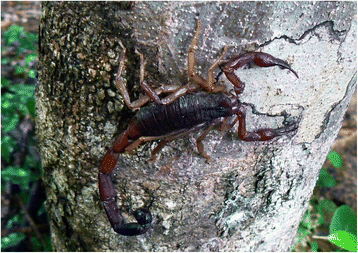
Grosphus ankarana Lourenço & Goodman (Buthidae). Female from the n of Madagascar
Source: https://jvat.biomedcentral.com/articles/10.1186/s40409-017-0138-3
Posted by: kiddmembech.blogspot.com

0 Response to "Evolution And The Scorpion Animal Or Crustaceon?"
Post a Comment